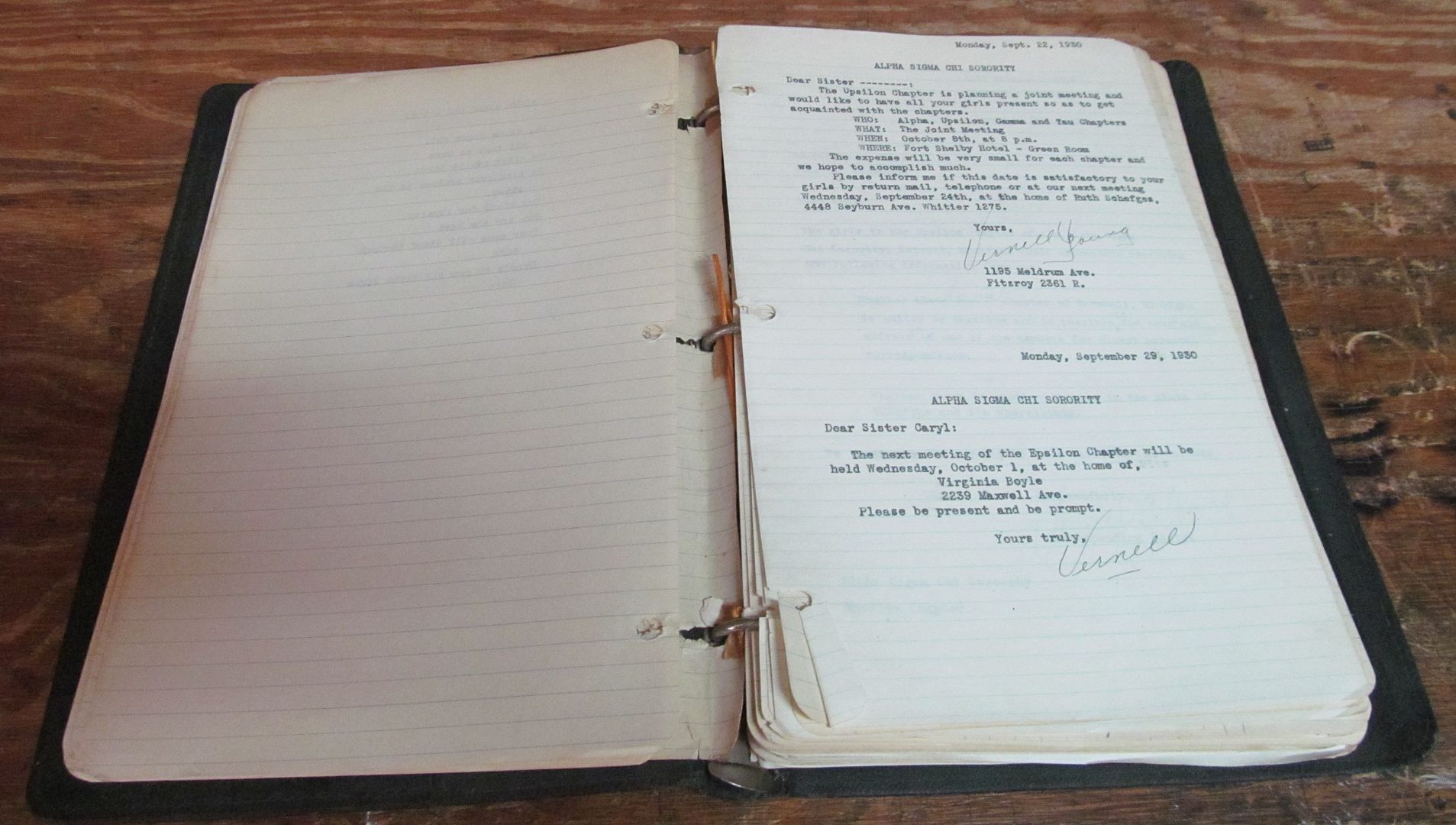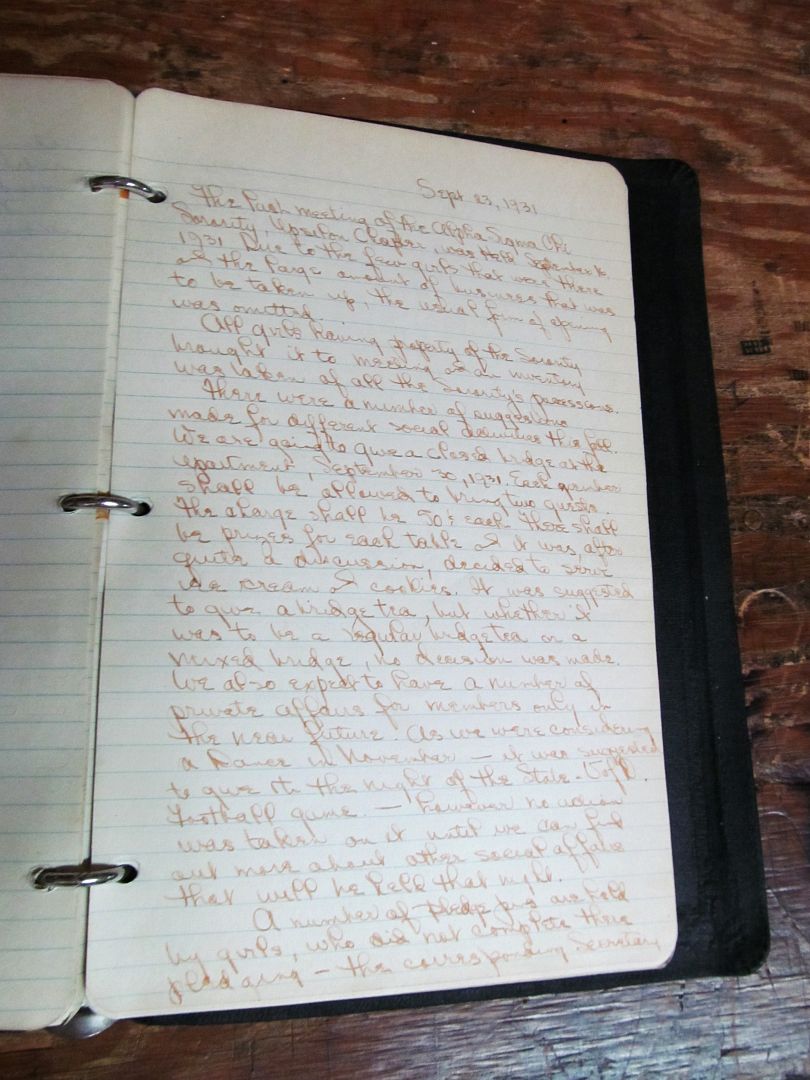
It was fun and surprising to browse through this notebook. I was expecting it to be mainly handwritten but most of the entries were neatly typed. While the notations were comprised of meeting notes and other formal/official chapter business, each secretary added little bits of her personality to what she wrote. A great deal of attention was given to pledges, from recruiting to initiating them. By today's standards what the pledges had to endure sounds pretty tame, but these girls were quite serious about who they let into their sorority -- and who they didn't:
"Miss Martha Meyers was voted upon for Pledge but received more than the quota of black balls allowed by the by-laws and therefore will mot be permitted into the Sorority."
If you're not familiar with the vintage version of black-balling, the members of old social groups like this would vote on membership matters by using actual white and black balls. They'd usually pair them with a wooden box that had a concealing cover or lid (this so each member could vote anonymously.)
I like seeing the handwriting of that era in the penned entries; in some cases it looks surprisingly modern, like this one:

It's also interesting to see the different social activities these girls enjoyed. Bridge seemed to be huge with this sorority; almost every entry mentions someone holding a game -- and sometimes who should bring what to it (I wonder if the cigarettes were the social norm or something sneaky.)
Aside from the entertainment value it holds, this notebook is a storyteller's goldmine of information. There are literally hundreds of full female names, addresses and personal details noted throughout the entries which are (obviously) authentic to the era. I have pages listing dozens of social events, activities, charities and work and school schedules as well as period prices for everything from food to jewelry.
I can also glean a lot from the tone of the entries. One secretary seemed to delight in tormenting pledges by repeatedly listing what must have been cruel initiation tasks (wearing a vegetable corsage or being dressed as a mummy? Horrors!) Not every secretary was a sorority snob; one sweetheart regularly mentioned members who were sick or hospitalized. Evidence of new financial hardships -- probably brought on in part by the 1929 Stock Market crash -- shows in how the sorority made two major adjustments in dues collecting and debt forgiveness. Right now I have enough material in just this one notebook to write an outline for a novel -- or draw on parts of it for three other story projects.
Some things to consider when using antique real-life material:
1. Unless you're writing a biography, always try to sufficiently alter or recombine names versus using them verbatim from your source document. While these people may no longer be alive they've probably got descendants, and it shows respect for their personal history.
2. Make copies of the original document for personal annotation or any form of alteration versus writing on the document itself. Keeping the source in its original condition helps preserve it for the next generation of storytellers.
3. Donate any historically important vintage journals to an appropriate museum, library or other nonprofit organization dedicated to preservation. While it's lovely to own a piece of history sharing it by donation will virtually guarantee its longevity. It will also make the information it contains available to teachers, students, researchers, curators, biographers etc.
If you're interested in finding your own vintage story mines, you can hunt for antique journals in a variety of places: thrift stores, rummage sales, old book stores, antique paper and emphemera dealers (try Etsy, which is where I found this one) and estate sales. For a marvelous free online resource, check out the massive list of links at The Diary Junction.

I was going to ask where you find such a treasure, but you've given some good leads. I would absolutely love to peruse this kind of journal or record. Getting a first-hand look into the past is fascinating, and you are right - what a goldmine for a writer as far as inspiration and historical accuracy. Now I have a reason to go into all of those antique stores filled with furniture that is too pricey for me!
ReplyDeleteYears ago I was rummaging through a dusty old box under a table at a thrift store and found an old ledger, the long skinny kind, covered with canvas-type material.
ReplyDeleteInside were pages and pages of recipes, not only handwritten from 1924-1932, but also filled with hundreds of clippings from newspapers and magazines of the time. It's even divided into sections: snacks, lunch, dinner, desserts and party food.
This piece of history once belonged to a woman who made her own amazing cookbook. And now it's one of my treasures.
I love your sorority notebooks! What a great find.
This is fascinating. Just reading your descriptions is giving me ideas. I'm going to be looking for something similar.
ReplyDeleteI'd have never thought of this, but it makes perfect sense. What better way to write in the times and have all the correct information right there. No way can anyone tell you something wasn't/didn't/couldn't if you have it in personal words. Just like OMG was first seen in a 1917 letter to Winston Churchill, and not invented by a 1980's teen, what a wealth of just...stuff that would all be era rich with details.
ReplyDeleteHi Sheila, Many thanks for mentioning The Diary Junction. Unfortunately, it's quite hard to keep up to date, so sometimes the links become redundant. Please do let me know if you find any bad ones. Also, I regularly publish articles on diaries/diarists in The Diary Review, and always aim to direct readers to freely available texts online, and to include actual diary texts. Regards. Paul
ReplyDeleteI am working on a book about royal, clever and famous dogs, and I have seen, that lady Minto has told about the family dog a dandy dinmont terrier in 1905, when the family left Dachingan Camp in Kasmir. I would be very happy, if someone could give me the correct text. I would love to read the book, but you cannot get it in Denmark, and I cannot wait weeks, as I am going to deliver the manuscript. Best regards from Gitte Kjaer, Denmark.
ReplyDeleteLady Mary Minto's India journal is available to read for free online. You can find it at https://archive.org/search.php?query=Mary%20Minto
Delete